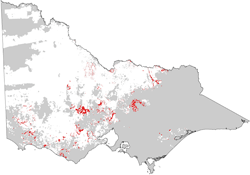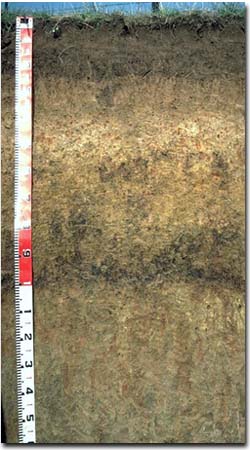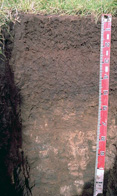Victorian Grain Cropping Soils - Dermosols
Back to: Soils of Victorian Grain Cropping Regions
Dermosols are structured soils that lack strong texture contrast between surface (A) horizons and subsoil (B) horizons. In many areas of Victoria, these soils are associated with hills, or are in high rainfall areas, so are not extensively used for grain cropping.
Distribution
| In north-east and central Victoria, Red Dermosols can occur on older river terraces and hillslopes. In higher rainfall areas these soils are typically strongly acid throughout. In the Rutherglen region, Brown and Yellow Dermosols can occur on the higher level plains and lower rise slopes. |  |
| Soil Pit Site NE39 is an example of a Yellow Dermosol near Rutherglen. |  Yellow Dermosol near Rutherglen. |
| Black and dark brown Dermosols occur on volcanic ash deposits in south-west Victoria. These are well structured and friable soils that are particularly suited to cropping. |  Brown Dermosol |
In central Victoria, Brown Dermosols occur on better-drained areas on the gently undulating volcanic plain and associated rises south of Maryborough. These are generally moderately deep and well structured. In some areas, stony soil profiles will be an impediment to cropping.
Management Considerations
Management strategies for all soils should include: increasing organic matter levels in the surface soil, minimising the degradation of soil aggregates and porosity, promoting the development of stable biopores, improving the calcium status of the cation exchange complex (particularly when sodium is a significant part), and breaking up any hardpans. Less frequent tillage, using less aggressive implements and working the soil at its optimum moisture content, can all assist in maintaining soil aggregation and porosity, as well as reducing the breakdown of organic matter.
In strongly acid surface soils, levels of exchangeable aluminium can become high which can affect the growth of aluminium sensitive species (e.g. phalaris, medics, sub clover, white clover and tall fescue). A pH/aluminium test sampled across the paddock level may be appropriate to determine lime requirements. Other factors need to be considered before lime is recommended (e.g. pasture species grown, method of application, local trial responses, soil surface structure and likely cost/benefit). Also, in strongly acid surface soils, deficiencies in molybdenum and phosphorus may occur. High levels of exchangeable aluminium will tend to "fix" phosphorus and make it unavailable to plants. Increasing soil pH (by the addition of lime) enable phosphorus (from phosphorus application) to be more readily available.
Dermosols, in general, are relatively well drained due to the gradational soil profile and often have well-developed structure, particularly in the upper subsoil. This allows more effective drainage compared to texture contrast soils. Red and Brown Dermosols are generally better drained than Yellow and Grey (usually mottled) counterparts which are more prone to waterlogging.
If the subsurface and/or upper subsoil horizons disperse after remoulding then tillage should be avoided if they are in a moist to wet condition. Physical disturbance to these horizons whilst in this condition can result in structural degradation occurring (e.g. plough pans).
Black Dermosols, associated with volcanic ash deposits in south-west Victoria, are friable and very well structured. They are also high in clay and as a result can be prone to compaction. Some also tend to be relatively high in free iron oxide which can result in P being tightly bound. The surface soil and upper subsoil is strongly structured (parting to many fine polyhedral shaped peds) and usually friable when moist, providing a suitable environment for root and water movement.


